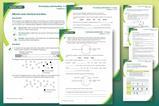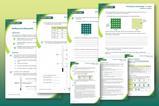Defining scientific words clearly, simply and accurately isn’t easy. This will help
Header in print: The hazards of simplicity
To help students understand scientific vocabulary, we need to give them clear, yet simple definitions. A good definition includes words appropriate to the stage of learning of the students. And we must take care that this simplification doesn’t introduce or reinforce misconceptions.
Writing good quality definitions is a challenge. Scientific words are usually chosen with great care. It is the everyday words that connect them that are more problematic. Imprecise use of everyday language to convey scientific meaning can result in students interpreting a definition in an unintended way.

If creating an improved definition is proving challenging, consider using the existing definition but clarifying it with students afterwards. This enables you to challenge any misconceptions from the start. This may help to avoid continued reinforcement of a misconception every time a student recalls the definition.
Here are some examples of commonly used definitions which may either reinforce existing misconceptions or induce later misunderstandings.
Finite resource
During teaching about fossil fuels, we regularly need to explain what is meant by the term ‘finite resource’. A typical simple definition is ‘A finite resource, such as a fossil fuel, can be used up’.
This may be clear and adequate for the topic. However, this use of language may encourage misunderstandings about combustion.
Some students hold the misconception that during a reaction a reactant simply disappears. Combustion is easily misunderstood because the products of the reaction (carbon dioxide and water) are in the gas state and so not visible.
‘A finite resource, such as a fossil fuel, cannot be replaced once it has been burned’ is a better definition.
Teaching idea
If you use the original definition, follow it up with diagnostic questioning, such as this from BEST. This may help reveal whether students have misconceptions about combustion reactions allowing these to be challenged.
Compound
A common definition of a compound is ‘a substance formed by the combination of elements in fixed proportions’. This does nothing to challenge the misconception that the properties of a compound are a combination of the properties of the original elements.
‘A compound is made up of a combination of atoms (or ions) of different elements’ makes clear that the compound is not a combination of the actual elements.
Teaching idea
Emphasise through teaching that the properties of a compound emerge from the arrangement and type of atom and not the additive properties of the elements.
For background on the research evidence relating to additive versus emergent thinking, read BEST key concept CPS2.1: Atoms and molecules.
Atom
Atoms are typically introduced in the curriculum before subatomic particles so these may not be used as part of the definition at this stage. A frequently used definition is ‘An atom is the smallest part of an element that can exist’ or words to that effect. This may encourage students to think of an atom as a tiny fragment of the element and consequently that an atom has the same properties as the bulk element (eg that a copper atom is orange in colour), which, of course, an atom does not. This may also contribute to misunderstandings about the properties of compounds.
Some textbooks add the word particle to the definition which may help reduce this misconception. For example, ‘An atom is the smallest particle that makes up an element’.
Teaching idea
Take care when drawing particle diagrams. Make sure the colour of atoms is clearly referenced to a key and avoid colours linked to the actual elements (eg orange for copper). It may help to use shading rather than colours.
If using a physical model, such a building blocks, make clear it is a model. Challenge students to critique the model; you could try the Response Sweet model from BEST.
pH
pH is defined scientifically in terms of hydrogen ion concentration. However, pH is typically introduced to much younger students who have yet to learn about either ions or concentration. ‘pH is the strength of an acid or alkali’ is often used as a definition. At the time of teaching this may seem sufficient. However, later when students are introduced to strong and weak acids, this can cause confusion. pH relates to the solution and not the type of acid.
The definition, ‘pH is a measure of how acidic or alkaline a solution is,’ is more consistent with later understanding.
Teaching idea
Having tested the pH of an acid, dilute the acid and test again. This shows students that pH is affected by the dilution and that solutions of the same type of acid can have different pH.

Topics
Avoid the pitfalls of language

Help students learn the difference between everyday and chemistry vocabulary
- 1
 Currently
reading
Currently
reading
Avoid the pitfalls of language: part 2
















1 Reader's comment